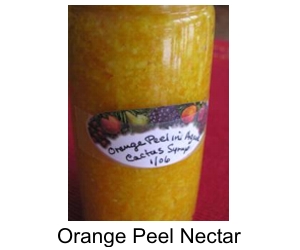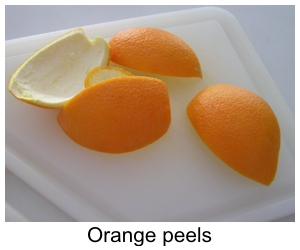 This is so easy to make, tasty and versatile with the surprise bonus of lowering cholesterol! It can be added to hot and cold s/cereals, baked products, sandwiches, salad dressings, spreads, jams and jellies. You’ll find other ways to enjoy it too, I’m sure! 1 tablespoon is recommended daily for therapeutic benefits. (See additional information below.)
This is so easy to make, tasty and versatile with the surprise bonus of lowering cholesterol! It can be added to hot and cold s/cereals, baked products, sandwiches, salad dressings, spreads, jams and jellies. You’ll find other ways to enjoy it too, I’m sure! 1 tablespoon is recommended daily for therapeutic benefits. (See additional information below.)
Organic Orange Peel with Agave Nectar
Yields about 1 cup
- Peels of 2 organic oranges (about 1 cup, chopped)
- 1/4 c. agave cactus nectar (a low glycemic syrup)
Chop peels into about 1/2 inch pieces. Put into a plastic freezer bag to freeze overnight or longer. Remove from fridge and process in the blender or food processor for about 30 seconds on chop, then for another 30 seconds on grind. Reduce grind time for a coarser texture.
Place in a bowl and stir in agave nectar. Store in glass bottle in the refrigerator. Use daily.
Variations: Combine orange with organic lemon or lime, if available. Substitute maple syrup or honey for agave.
Compounds in Orange Peels
Compounds in Orange Peel May Lower Cholesterol as Effectively as Statin Drugs
 A class of compounds found in citrus fruit peels called polymethoxylated flavones (PMFs) have the potential to lower cholesterol more effectively than some prescription drugs, and without side effects, according to a study by U.S. and Canadian researchers that was published in the May 2004 issue of the Journal of Agricultural and Food Chemistry.
A class of compounds found in citrus fruit peels called polymethoxylated flavones (PMFs) have the potential to lower cholesterol more effectively than some prescription drugs, and without side effects, according to a study by U.S. and Canadian researchers that was published in the May 2004 issue of the Journal of Agricultural and Food Chemistry.
In this study, when hamsters with diet-induced high cholesterol were given the same diet containing 1% PMFs (mainly tangeretin), their blood levels of total cholesterol, VLDL and LDL (bad cholesterol) were reduced by 19-27 and 32-40% respectively. Comparable reductions were also seen when the hamsters were given diets containing a 3% mixture of two other citrus flavonones, hesperidin and naringin.
Treatment with PMFs did not appear to have any effect on levels of beneficial HDL cholesterol, and no negative side effects were seen in the animals fed the PMF-containing diets.
Although a variety of citrus fruits contain PMFs, the most common PMFs, tangeretin and nobiletin, are found in the peels of tangerines and oranges. Juices of these fruits also contain PMFs, but in much smaller amounts. In fact, you’d have to drink about 20 glasses of juice each day to receive an amount of PMFs comparable in humans to that given to the hamsters. However, grating a tablespoon or so of the peel from a well-scrubbed organic tangerine or orange each day and using it to flavor tea, salads, salad dressings, yogurt, soups, or hot oatmeal, buckwheat or rice may be a practical way of achieving some cholesterol-lowering benefits. The researchers are currently exploring the mechanism of action by which PMFs lower cholesterol. Based on early results in cell and animal studies, they suspect that PMFs work like statin drugs, by inhibiting the synthesis of cholesterol and triglycerides inside the liver.
Info on orange peels came from the nutritional website of Gerge Mateljan, founder of Health Valley Foods, www.whfoods.com.
